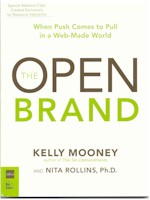 |
|
|
| ||||||
|
|
This page is the original source of this review, though you may also find it on Amazon or other sites. | ||
| Book Reviews Home | Free Audio Books | |
 |
Book Review of: Open BrandWhen Push Comes to Pull in a Web-Made World Price: $16.49 Availability: Usually ships
within 24 hours |
| Review
of
Open Brand, by Kelly Mooney and Nita Rollins, PhD (Paperback, 2008) (You can print this review in landscape mode, if you want a hardcopy) Reviewer: Mark Lamendola, author of over 6,000 articles. Anyone who is involved in marketing, product development, sales, public relations, or customer service should read this book. Traditionally, companies have developed their message and pushed it out to their customers--this is push marketing. Companies would push demand through the sales channels. So, the various efforts were company-driven: product development, marketing, sales, and customer service, to name a few. Today, the marketing model is increasingly a pull model. Customers pull demand through the various channels. And not just to the companies--but to a vast network of other people. This massive customer communication puts customers, not companies, in the driver's seat. If marketing is a show, the audience of customers now controls the stage. This is why a book like The Open Brand matters. The book consists of four Parts. Part One consists of three chapters. These focus on the concept of "Open." The author has an acronym:
These describe today's marketing environment. While customers are empowered due to online tools such as Instant Messaging, e-mail, blogs, and communities, the effects of their communications reach well beyond the online world into every nook and cranny of the offline world as well.
Part II discusses the iCitizen. The power of the consumer is far different from what it was a few years ago. What is this power, and how did the iCitizen end up with it? Who are iCitizens? Who has more influence--a few celebrities, or thousands of regular people who all have a voice? Part II answers these questions and more. It also explains how and why the iCitizen can be both the medium and the message. Part III explains the response to the iCitizen. It presents a strategic framework that allows a company to make sense of Part I (the social Web) and Part II (the iCitizen). It discusses the two trends that, more than any others, anchor the open brand framework:
Part IV is titled "Getting to Open." It's based on what the authors call "The Four OPEN Experiences." Different people experience the Web in different ways. The authors classify these as:
Do you know which group (or experience) has the most power? The answer may surprise you, and that's OK. What's not OK is not learning the answer and doing something about it. What you do, exactly, depends on several interdependent factors. Part IV addresses those. When you're done reading this book, you'll have an understanding of who is really driving many of the choices companies make. More importantly, you'll have a framework for developing a suitable response with long-term viability. The book has an appendix with a glossary, acknowledgements, and index. | |
|
This page is the original source of this review, though you may also find it on Amazon or other sites. | ||
| Book Reviews Home | Free Audio Books | |
About these reviewsYou may be wondering why the reviews here are any different from the hundreds of "reviews" posted online. Notice the quotation marks? I've been reviewing books for sites like Amazon for many years now, and it dismays me that Amazon found it necessary to post a minimum word count for reviews. It further dismays me that it's only 20 words. If that's all you have to say about a book, why bother? And why waste everyone else's time with such drivel? As a reader of such reviews, I feel like I am being told that I do not matter. The flippancy of people who write these terse "reviews" is insulting to the authors also, I would suspect. This sound bite blathering taking the place of any actual communication is increasingly a problem in our mindless, blog-posting Webosphere. Sadly, Google rewards such pointlessness as "content" so we just get more if this inanity. My reviews, contrary to current (non) standards, actually tell you about the book. I always got an "A" on a book review I did as a kid (that's how I remember it anyhow, and it's my story so I'm sticking to it). A book review contains certain elements and has a logical structure. It informs the reader about the book. A book review may also tell the reader whether the reviewer liked it, but revealing a reviewer's personal taste is not necessary for an informative book review. About your reviewer
About reading styleNo, I do not "speed read" through these. That said, I do read at a fast rate. But, in contrast to speed reading, I read everything when I read a book for review. Speed reading is a specialized type of reading that requires skipping text as you go. Using this technique, I've been able to consistently "max out" a speed reading machine at 2080 words per minute with 80% comprehension. This method is great if you are out to show how fast you can read. But I didn't use it in graduate school and I don't use it now. I think it takes the joy out of reading, and that pleasure is a big part of why I read. |
| |||||